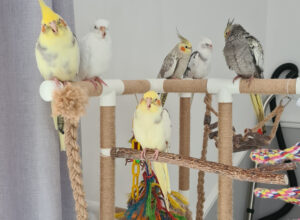tHe Basics Of Cockatiel Communication
Key Takeaways
- Understand the basic sounds and body language of cockatiels for effective communication.
- Recognise signs of happiness, stress, illness, and bonding.
- Implement daily care routines and a safe environment to support your cockatiel’s well-being.
- Learn how vocalisations and physical cues offer insight into your bird’s needs and feelings.
Cockatiels are one of the most popular companion birds in the UK, known for their charming personalities and capacity for communication. As a cockatiel owner and enthusiast, I’ve come to understand the subtleties of their language, both vocal and physical.
Cockatiels communicate through a combination of vocal sounds and body language, each with distinct meanings. Learning to interpret these signals is crucial for any cockatiel owner. This guide will provide you with the foundational knowledge to start understanding and responding to your bird’s unique way of expressing itself.
Understanding Vocalisations
Cockatiels are vocal birds, using a variety of sounds to express their emotions, desires, and to interact with their human companions. Here’s a breakdown of common vocalisations:
- Whistling and Singing: Often a sign of happiness and contentment. Cockatiels may whistle tunes they have learned or invent their own to get attention.
- Chirping: Short, repetitive chirps can indicate curiosity or a mild call for attention.
- Screaming: Loud, harsh sounds are usually expressions of fear, excitement, or seeking attention. Consistent screaming might be a sign of stress or boredom.
- Hissing: A defensive sound, indicating fear, discomfort, or annoyance.
- Beak Clicking / Beak Grinding: This can be a sign of contentment when coupled with fluffed feathers and sleepy eyes.
Reading Body Language
Body language offers additional clues to a cockatiel’s emotional state:
- Head Bobbing: Can signify excitement, curiosity, or the desire to be fed (especially in younger birds).
- Feather Fluffing: When relaxed, a cockatiel will fluff its feathers. However, if accompanied by hissing or beak clicking, it’s a defensive gesture.
- Wing Flapping: May indicate a desire to exercise or show off. In some cases, it’s a way to attract attention.
- Tail Wagging: Similar to a dog, a cockatiel may wag its tail as a sign of happiness or after grooming itself.
- Eye Pinning: The rapid dilation and contraction of the pupil can indicate excitement or agitation.
Noises and Body Language Tables
To further clarify, here are two tables summarising the key points:
Common Vocalisations
| Noise or Sound | Meaning |
|---|---|
| Whistling/Singing | Happiness, Contentment |
| Chirping | Curiosity, Attention-Seeking |
| Screaming | Fear, Excitement, Stress |
| Hissing | Discomfort, Annoyance |
| Beak Clicking | Contentment, Warning |
Body Language Indicators
| Indicator | Meaning |
|---|---|
| Head Bobbing | Excitement, Curiosity |
| Feather Fluffing | Relaxation, Defence |
| Wing Flapping | Exercise Desire, Attention-Seeking |
| Tail Wagging | Happiness, Post-Grooming |
| Eye Pinning | Excitement, Agitation |
Enhancing Communication with Your Cockatiel
Effective communication with your cockatiel involves more than just understanding its signals. Creating a bond through regular interaction, training, and responding appropriately to its communication efforts is key. Here are some tips:
- Daily Interaction: Spend time with your cockatiel daily to strengthen your bond and improve mutual understanding.
- Positive Reinforcement: Use treats and praise to encourage desired behaviours, especially when training.
- Observation: Pay close attention to your bird’s vocalisations and body language to identify patterns or changes that might indicate its needs or health issues.
Conclusion
Understanding your cockatiel’s way of communicating is essential for a harmonious relationship. By paying attention to their vocalisations and body language, you can better meet their needs, recognise signs of distress, and enjoy the rewarding experience of companionship with these engaging birds. Remember, patience and consistent interaction are key to deepening your bond and enhancing communication.
For more detailed guides on cockatiel care, including setting up your bird’s cage, feeding basics, and health care, explore our series on Essential Cockatiel Care and related topics. Each aspect of care plays a significant role in your cockatiel’s physical and emotional well-being, contributing to a fulfilling life together.

